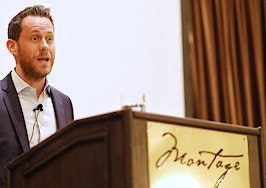Earlier this year, a sprawling San Diego-area estate that had been owned by weight loss guru Jenny Craig was about to close for $22 million. And Audie Chamberlain, founder of public relations firm Lion & Orb, was tasked with spreading the word.
Chamberlain, an expert in real estate publicity, opted for a press-centric strategy. Shortly before the deal closed, he recounted Wednesday at Inman Luxury Connect, he reached out to the real estate desk at the Los Angeles Times. Chamberlain promised the Times that they could have the scoop, on the condition that they didn’t report on the sale until it became public information — a common practice in the media known as having an embargo.
The Times agreed and when the time came, the story went live in the paper. From there, Chamberlain said, it was picked up by other outlets including TMZ. Before long, he continued, the news had reached 3.3 million consumers via various media outlets.
“Once you get it our there then everyone starts talking about the property,” Chamberlain said. “We did that in minutes.”
The case highlights how a successful media strategy can significantly boost the profile of a property and, perhaps more significantly, an agent. And of course a higher profile should translate into more business.

Audie Chamberlain at Inman Luxury Connect Wednesday | Credit: AJ Canaria of PlanOmatic
Chamberlain said there were several takeaways for agents from the Jenny Craig estate sale. First, he advised agents who want to generate publicity to focus on the properties that are sold or about to close.
“The more you maximize your sold [properties] the more listing opportunities you’re going to get,” he said.
Focusing on sold properties may not drum up new buyers for those specific listings, but it helps broadcast to other people — both in real estate and not — that an agent can close deals and handle high-end transactions. It’s a credibility boost.
Chamberlain also encouraged agents to think critically about when to time their publicity pushes — media embargoes can be useful for that — and to do their research on the outlets they want to get into. Know who covers what, he explained, and the kinds of stories they might be interested in picking up.
“You’re going to reach out to your local paper, the person who covers real estate,” he added. “So look at the last three articles they wrote.”
During his presentation, Chamberlain also asked how many agents in the packed room thought they had a newsworthy listing at the moment. Only a few hands went up.
It was an understandable response, given that Chamberlain’s example had been the flashy coastal estate of a public figure.
But he also argued that press-worthy listings are not limited to famous homes or those that sell for massive fortunes. Instead, relatively modest homes can sometimes attract significant attention if agents figure out how to frame a compelling narrative about them. The key, he said, is figuring out an interesting angle and going with it.
“Think about the different stories you can tell,” he concluded.





